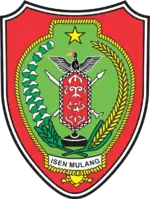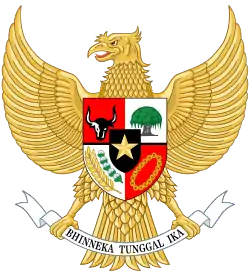Central Kalimantan
Central Kalimantan (Indonesian: Kalimantan Tengah), is a province of Indonesia. It is one of five provinces in Kalimantan, the Indonesian part of Borneo. Its provincial capital is Palangkaraya and in 2010 its population was over 2.2 million,[5] while the 2015 showed a rise to 2.49 million and the latest official estimate (for mid 2019) is 2,649,803.[6]
Central Kalimantan | |
|---|---|
 Flag  Coat of arms | |
| Motto(s): Isen Mulang (Persistent) | |
 Location of Central Kalimantan in Indonesia. | |
| Coordinates: 2°13′S 113°55′E | |
| Capital and largest city | Palangka Raya |
| Government | |
| • Body | Central Kalimantan Provincial Government |
| • Governor | Sugianto Sabran |
| • Vice Governor | Said Ismail |
| Area | |
| • Total | 153,564.5 km2 (59,291.6 sq mi) |
| Area rank | 2nd |
| Population (mid 2019)[1] | |
| • Total | 2,649,803 |
| • Density | 17/km2 (45/sq mi) |
| Demographics | |
| • Ethnic groups | 46% Dayak22% Javanese21% Banjarese 3.9% Malay1.9% Madurese 4.8% other[3] |
| • Religion (2017)[4] | 70.0% Islam 16.4% Protestant 8.09% Hindu/Kaharingan 4.56% Catholic 0.65% Buddhism 0.1% other |
| • Languages | Indonesian (official) Malay Bugis Dayak Chinese (Hakka and Teochew) |
| Time zone | WIB (UTC+7) |
| HDI 2019 | |
| HDI rank | 21st in Indonesia (2019) |
| Website | kalteng.go.id |
The population growth rate was almost 3.0% per annum between 1990 and 2000, one of the highest provincial growth rates in Indonesia during that time; in the subsequent decade to 2010 the average annual growth rate slowed markedly to around 1.8%, but it rose again in the decade beginning 2010. More than is the case in other province in the region, Central Kalimantan is populated by the Dayaks, the indigenous inhabitants of Borneo.
History
Since the eighteenth century the central region of Kalimantan and its Dayak inhabitants were ruled by the Muslim Sultanate of Banjar. Following Indonesian independence after World War II, Dayak tribes demanded a province separate from South Kalimantan province.[7]
In 1957 South Kalimantan was divided to provide the Dayak population with greater autonomy from the Muslim population in the province. The change was approved by the Indonesian Government on 23 May 1957 under Presidential Law No. 10 Year 1957, which declared Central Kalimantan the seventeenth province of Indonesia. President Sukarno appointed the Dayak-born national hero Tjilik Riwut as the first Governor and Palangkaraya the provincial capital.[8]
| Year | Pop. | ±% |
|---|---|---|
| 1971 | 701,936 | — |
| 1980 | 954,353 | +36.0% |
| 1990 | 1,396,486 | +46.3% |
| 1995 | 1,627,453 | +16.5% |
| 2000 | 1,801,965 | +10.7% |
| 2005 | 1,914,900 | +6.3% |
| 2010 | 2,212,089 | +15.5% |
| 2015 | 2,490,178 | +12.6% |
| 2019 | 2,649,803 | +6.4% |
| Source: Badan Pusat Statistik 2019 | ||
Geography
Central Kalimantan is the third largest Indonesian province by area with a size of 153,564.5 km2, about 1.5 times the size of the island of Java. It is bordered by West Kalimantan and East Kalimantan provinces to the north, by the Java Sea to the south, by South Kalimantan and East Kalimantan provinces to the east, and by West Kalimantan province to west.
The Schwaner Mountains stretch from the north-east of the province to the south-west, 80% of which is covered in dense forest, peatland swamps, mangroves, rivers, and traditional agriculture land. Highland areas in the north-east are remote and not easily accessible. Non-volcanic mounts are scattered in this area including Kengkabang, Samiajang, Liang Pahang and Ulu Gedang.
The centre of the province is covered with tropical forest, which produces rattan, resin and valuable timber such as Ulin and Meranti. The southern lowlands are dominated by peatland swamps that intersect with many rivers. Sabangau National Park is a protected peatland area internationally acknowledged as sanctuary for the endangered Orangutan. Recently the peat swamp forests have been damaged by the Mega Rice Project, which unsuccessfully sought to turn large areas into rice paddies.
The province's climate is wet weather equatorial zone with an eight-month rainy season, and 4 months of dry season. Rainfall or precipitation is 2,776 – 3,393 mm per year with an average of 145 rainy days annually.
Rivers
Central Kalimantan has numerous rivers from the catchment areas to the north in the Schwaner Mountains, flowing to the Java Sea. The major rivers include:
- Barito River (900 km)
- Kapuas River (600 km)
- Kahayan River (600 km)
- Katingan River (600 km)
- Mentaya (Sempit) River (400 km)
- Seruyan River (350 km)
- Lamandau River (300 km)
- Arut River (250 km)
- Sabangau River (200 km)
- Kumai River (179 km)
- Jelai River (100 km)
Rivers are an important mode of transportation and a primary location for settlement. With relatively undeveloped infrastructure, the province's economy relies heavily on the rivers.
Administrative divisions
Central Kalimantan is administratively divided into thirteen regencies (kabupaten) – each headed by a regent – and one city (kotamayda), the latter being Palangka Raya (the provincial capital). These are as follows:
| Name | Area in Sq. km | Population 2000 Census | Population 2010 Census | Population 2015 Census | Population Estimate 2019 | Capital | HDI[9] 2019 estimate |
|---|---|---|---|---|---|---|---|
| Palangkaraya City | 2,399.50 | 158,770 | 220,962 | 259,205 | 281,096 | Palangkaraya | 0.808 (Very High) |
| East Barito Regency (Barito Timur) | 3,834.00 | 71,907 | 97,372 | 113,821 | 122,285 | Tamiang Layang | 0.713 (High) |
| East Kotawaringin Regency (Kotawaringin Timur) | 16,796.00 | 308,765 | 374,175 | 425,293 | 449,354 | Sampit | 0.712 (High) |
| Gunung Mas Regency | 10,805.00 | 74,823 | 96,990 | 109,768 | 115,567 | Kuala Kurun | 0.707 (High) |
| Kapuas Regency | 14,999.00 | 325,243 | 329,646 | 347,735 | 358,723 | Kuala Kapuas | 0.694 (Medium) |
| Katingan Regency | 17,500.00 | 121,047 | 146,439 | 160,049 | 170,006 | Kasongan | 0.686 (Medium) |
| Lamandau Regency | 6,414.00 | 47,969 | 63,199 | 73,757 | 79,647 | Nanga Bulik | 0.705 (High) |
| Murung Raya Regency | 23,700.00 | 74,050 | 96,857 | 110,199 | 116,529 | Purukcahu | 0.679 (Medium) |
| North Barito Regency (Barito Utara) | 8,300.00 | 109,273 | 121,573 | 127,357 | 130,631 | Muara Teweh | 0.705 (High) |
| Pulang Pisau Regency | 8,997.00 | 111,488 | 120,062 | 124,792 | 127,175 | Pulang Pisau | 0.683 (Medium) |
| Seruyan Regency | 16,404.00 | 92,037 | 139,931 | 174,177 | 198,356 | Kuala Pembuang | 0.676 (Medium) |
| South Barito Regency (Barito Selatan) | 8,830.00 | 108,560 | 124,128 | 131,877 | 136,847 | Buntok | 0.701 (High) |
| Sukamara Regency | 3,827.00 | 29,561 | 44,952 | 55,132 | 62,024 | Sukamara | 0.680 (Medium) |
| West Kotawaringin Regency (Kotawaringin Barat) | 10,759.00 | 168,472 | 235,803 | 277,416 | 301,563 | Pangkalan Bun | 0.729 (High) |
| Totals | 153,564.50 | 1,801,965 | 2,212,089 | 2,490,178 | 2,649,803 | Palangka Raya | 0.709 (High) |
In addition to the civil service, Central Kalimantan also recognises a traditional governing system led by traditional leaders known as Demang. The province is divided into 67 traditional law areas known as Kademangan, headed by Demang. The system is intended to culturally recognise and preserve the customs and heritage of the Dayak tribes.
Railroads
Russia contracted to build railroads from Central Kalimantan to East Kalimantan for coal transportation with estimated cost of US$2.4 billion, starting in 2013 and completing in 2017. [10]
Demographics
Religion
The population of Central Kalimantan is 74.31% Muslim, 18.6% Christian (15.97% Protestant and 2.63% Catholic), 0.50% Hindu, 0.11% Buddhist, and 6.26% other.[11]
The religious composition have changed a lot from 1971, when 55% of the population was Muslim, 16% Christian, 1% Hindu and 28% Kaharingan. In 1980, Kaharingan was recognized as a form of Hinduism, but this didn't slowed down its decline. Proportion of Kaharingan adherents went down to 15.75% in 1990 and was reported at 5.89% in 2000.[12]
Ethnic groups
The three major Dayak tribes in Central Kalimantan are the Ngaju, Ot Danum and Dusun Ma'anyan Ot Siang. The three major tribes extended into several branches of prominent Dayak tribes in Central Kalimantan such as Lawangan, Taboyan, Dusun Siang, Boyan, Bantian, Dohoi and Kadori.
In addition to the indigenous Dayak tribes, there are also ethnic groups from other areas of Indonesia, including Malays, Javanese, Madurese, Batak, Toraja, Ambonese, Bugis, Palembang, Minang, Banjarese, Makassar, Papuan, Balinese, Acehnese and also Chinese.
Ethnic groups as per 2000 census[13]
| Ethnic Group | Islam | Christian | Hindu | Other | % of Population |
|---|---|---|---|---|---|
| Banjarese | 99% | 0% | 0% | 0% | 24.6% |
| Javanese | 96% | 4% | 0% | 0% | 18.8% |
| Ngaju Dayak | 43% | 44% | 13% | 0% | 18.0% |
| Sampit Dayak | 82% | 9% | 9% | 0% | 9.6% |
| Bakumpai | 99% | 0% | 0% | 0% | 7.5% |
| Madurese | 100% | 0% | 0% | 0% | 3.5% |
| Katingan Dayak | 37% | 22% | 32% | 9% | 3.3% |
| Maanyan | 4% | 86% | 9% | 1% | 2.8% |
| Tomun Dayak | 18% | 56% | 17% | 2% | 2.2% |
| Sundanese | 99% | 1% | 0% | 0% | 1.4% |
| Dusun Dayak | 9% | 29% | 63% | 0% | 1.1% |
| Siang Dayak | 6% | 40% | 48% | 4% | 0.9% |
| Manyan Dayak | 20% | 70% | 10% | 0% | 0.7% |
| Ot Danum | 10% | 51% | 38% | 0% | 0.6% |
| Other non-Dayak | NA | NA | NA | NA | 1.3% |
| Other Dayak | NA | NA | NA | NA | 5.0% |
References
- Badan Pusat Statistik, Jakarta, 2019.
- Indonesia's Population: Ethnicity and Religion in a Changing Political Landscape. Institute of Southeast Asian Studies. 2003.
- Aris Ananta; Evi Nurvidya Arifin; M. Sairi Hasbullah; Nur Budi Handayani; dan Agus Pramono (2015). Demography of Indonesia’s Ethnicity. Institute of Southeast Asian Studies dan BPS – Statistics Indonesia.
- "Provinsi Kalimantan Tengah Dalam Angka 2018". BPS Kalimantan Tengah. Retrieved 13 September 2018.
- Biro Pusat Statistik, Jakarta, 2011.
- Badan Pusat Statistik, Jakarta, 2019.
- Profile Central Kalimantan Province. Central Kalimantan Province Tourism and Culture Board. September 2001.
- Riwut, Nila; et al. (October 2003). Maneser Panatau Tatu Huang. Pusaka Lima. ISBN 979-97999-1-0.
- Russian firm signs MoU to build $2.4 billion railway
- "Population by Region and Religion in Indonesia". BPS. 2010.
- https://espace.curtin.edu.au/bitstream/handle/20.500.11937/35283/120656_12034_49851.pdf?sequence=2
- https://espace.curtin.edu.au/bitstream/handle/20.500.11937/35283/120656_12034_49851.pdf?sequence=2
External links
- Official website (in Indonesian)
- Official statistics for the province, provided by the Indonesian Central Bureau of Statistics, may be accessed (Indonesian language) at Badan Pusat Statistik Propinsi Kalimantan Tengah.
